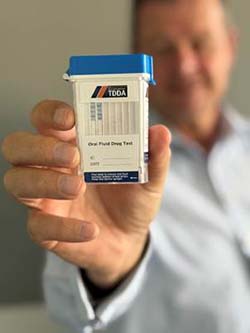
Opioids And Amphetamines Rising In New Zealand Workplaces
Posted: 31-Jul-2025 |
The Drug Detection Agency (TDDA), New Zealand’s largest workplace drug testing provider, has released its Imperans Q2 2025 workplace drug findings. The data show New Zealand’s workplaces are seeing a rapid increase in opioid use, especially tramadol, and amphetamine-type substances (ATS) are driving regional spikes in positive tests.
The Imperans Report provides New Zealand employers with an analysis of drug usage trends, evolving risks, and aggregated national testing results. It empowers businesses to manage workplace risk and adapt their drug and alcohol policies, testing, and educations programmes.
In Q2 2025 tests from 27 clinic locations and 60 mobile clinics throughout New Zealand were collected. Overall positivity rates held steady at 3.31%, mirroring Q1. The findings suggest that substance use among workers is holding steady, but their drug selection continues to shift in a dangerous direction.
Opioids now account for 18.9% of all positive results, up 1.5% from Q1. Tramadol alone made up 3.1% of detections. This development echoes growing global concern prescription opioid misuse, particularly its dependence risks and links to risks of impairment.
Amphetamine-type substances (ATS) made up 31.0% of positives. While slightly down from Q1 (31.6%), this drug type is still elevated against late 2024 levels (30%), signalling persistent methamphetamine activity in New Zealand’s workplaces.
Cannabis (THC) detections have eased slightly, yet in regions like Gisborne and Tasman, THC remains the dominant substance detected, surpassing 75% of all positive screens.
TDDA workplace testing showed the most prevalent substances detected across all positive tests in New Zealand:
Cannabis (THC): was present in 63.3% of positive tests down 5.4% from 68.7% in Q1 2025.
Amphetamine-type substances (ATS): 31.0%, down 0.6%. Opiates and opioids (including ‘oxy’ and tramadol): 18.9%, up 4.6% ; Tramadol: accounted for 3.1% of opiate and opioid testing this quarter. Q2 marks is the first time TDDA has independently tested for Tramadol
Benzodiazepines: 4.7%, down 0.2%. Cocaine: unchanged at 1.7%
Region-specific spikes underline the challenge: Gisborne: THC represented 91.7% of local positives, an increase of 27% from Q1; ATS also rose from 11.8% to 33.3% in the same quarter. Tasman: THC increased from 58.3% in Q1 to 77.8% of local positives.
Bay of Plenty: Opioid detections jumped from 12.8% in Q1 to 25.4% of local positives
Auckland East: Opioid detections jumped from 10.2% in Q1 to 25.9% of local positives
The Lakes: ATS surged more than 22%, from 37% in Q1 to 59.6% of local positives.
“Our Q2 findings make it very clear that the types of substances people are taking changes rapidly. The rise in opioid detections, including tramadol positives, is a clear sign that employers must stay vigilant. Amphetamine and cannabis activity also remains a serious concern, they are dominant choice in several regions,” says Glenn Dobson, CEO, TDDA.
“Employers need to take a hard look at their policies and training. In high-risk environments, drugs and alcohol have catastrophic consequences for worker safety and business continuity. Businesses need to rapidly address any gaps in awareness on prescription opioids such as tramadol, especially in Bay of Plenty and Auckland East where we’re seeing sharp upticks.”
TDDA recommends that companies apply policies consistently, maintain fit for purpose testing programmes, provide education, and focus on understanding trends and region-specific issues to keep workplaces safe.
“Businesses cannot afford to be complacent. The drugs people are taking change rapidly. The shift to opiates and amphetamines need careful management because the data show substance misuse is evolving.” says Dobson.
“Drug use adapts to trends like cost, cartel activity and easy availability, and so must workplace policies. Businesses must invest in comprehensive drug education, fit-for-purpose testing programmes, and region-specific management to stay ahead of issues. Proactive investment today can safeguard both workers and operations tomorrow.”



 + EQUIPMENT GUIDE - FREE
+ EQUIPMENT GUIDE - FREE
